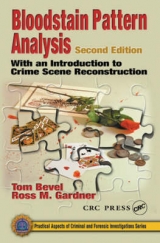
Bloodstain Pattern Analysis
Crc Press Inc (Verlag)
978-0-8493-8159-1 (ISBN)
- Titel erscheint in neuer Auflage
- Artikel merken
This in-depth reference covers the analysis of bloodstain patterns found at violent crime scenes and outlines a logical, effective method for crime scene reconstruction. Each of these analysis methods is presented in the context of how it is used to solve crimes. The book first explains the history and evolution of bloodstain analysis and defines standard terminology. It then draws on the authors' own extensive field experience to establish a working model for crime scene analysis and reconstruction. The book also explains the basic properties of blood, its physical make-up and response to injury.
The authors explain how to use bloodstain patterns to understand events that occurred at a crime scene. They cover key areas such as defining motion, finding the point of origin, identifying impact spatter, and spotting characteristic patterns. Bevel and Gardner conclude with a discussion of the use of logic in analysis, and look objectively at the various opinions and schools of thought among law enforcement professionals. All of the data on current philosophies and methods is the very latest, most up-to-date information available today. The authors teach courses on this topic and use this work as their prescribed textbook.
The text concludes with practical information on documenting and collecting bloodstain pattern evidence, presenting evidence in court, and contending with bloodborne pathogens. Numerous photographs graphically depict the concepts presented.
Bloodstain Pattern Analysis: Its Function and a Historical Perspective
The Function of Bloodstain Pattern Analysis
The Relationship of Bloodstain Pattern Analysis to Crime Scene Reconstruction
A Historical Perspective of Bloodstain Pattern Evidence
Early Scientific References
Modern Works in Bloodstain Pattern Analysis
Summary
Crime Scene Analysis and Reconstruction
Distinguishing Crime Scene Analysis from Behavioral Analysis
Limitations in the Reconstruction of Crime
A Conceptual Model for Analysis
Collection
Evaluation
Assessment
Integration
Event Analysis: A Process for Crime Scene Reconstruction
The Role of Logic in Analysis
Expectations and Predictions
Impact of Dynamic Events on the Reconstruction
Deductive vs. Inductive Reasoning
Informal Fallacies Encountered in Analysis
Putting the Pieces Together
Terminology
Referring to the Discipline
General Terms Relating to Bloodstain Pattern Analysis
Grouping Stains
Angle of Impact
Arterial Gushing and Spurts
Atomized Blood/Misting
Spatter
Clot
Capillary Action
Cast Off Stains
Directionality
Directional Angle
Drawback/Blowback Effect
Drip Patterns
Expiratory Blood
Flight Path
Impact Site
Origin/Point of Origin
Parent Stain
Projected Blood
Ricochet Stain
Satellite Spatter
Shadowing/Ghosting/Void
Skeletonized Stain/Skeletonization
Spines
Splash
Passive Flow
Pattern Transfer
Swipe
Wipe
Velocity Impact Patterns
Summary
Understanding the Medium of Blood
General Properties of Blood
Blood Make-Up
The Body's Response to Breaching of the Circulatory System
Circulatory System Considerations
Droplet Dynamics in Flight
Droplet Dynamics on Impact
Contact/Collapse
Displacement
Dispersion
Retraction
Liquid to Liquid Impacts
Stain Shape and Impact Angle Relationship
Summary
Determining Motion and Directionality
General Sequence of Events
Droplet Directionality
Recognizing Blood Trail Motion
Determining Motion from Wipes and Swipes
Repetitive Pattern Transfers
Flows
Summary
Determining the Point of Convergence and the Point of Origin
Determining Point of Convergence from Overhead
Determining Impact Angles
Stain Measurement
Determining Point of Origin Using Both Side and Overhead Views
Graphing Points of Origin
Defining Point of Origin with the Tangent Function
Limitations in Point of Origin Evaluations
Three-Dimensional Evaluations of Point of Origin
Stringing Scenes
Forensic Software Applications
Automation Efficiency or Precision - An Important Distinction
Summary
Evaluation Impact Spatter Bloodstains
Methods of Description
Understanding the Concept of Preponderant Stain Size
Distinguishing Spatter from Contact Stains
Impact Droplet Sizes
Pattern Configuration and Dispersion in Impacts
Spatter Resulting from Gunshots
Gunshot Spatter - Forward Spatter and Backspatter
Size Ranges of Gunshot Spatter
Kinetic Energy, Wound Cavitation, and the Creation of Gunshot Spatter
Gunshot Pattern Shapes and Dispersion
Expiratory Blood
Fly Spots
Summary
Characteristic Patterns of Blood Which Aid in Analysis
Cast-Off Stains
Pattern Transfers
Projected Blood
Flow Patterns
Voids and Ghosting Patterns
Pools and Standing Blood
Blood Dripping into Blood
Summary
Documenting Bloodstains
The Function of Documentation
Collection
Detection of Blood
Presumptive Tests
Enhancement Techniques
Bloodstain Pattern Photography
Scene and Pattern Sketches
Written Reports
Summary
Documenting the Reconstruction of a Crime
Reconstruction Report
Event Analysis in Outline Format
Statement Comparison to Event Analysis
Event Analysis in Narrative Format
Guidelines for Maintaining Objectivity During Case-Specific Experiments
Recreating Human Anatomy
Recreating Event Particulars
Pitfalls to Recreation Attempts
Case Examples
Summary
Automation Applications in Bloodstain Pattern Analysis and Crime Scene Reconstruction
Automation Usage Considerations
Types of Automation
Tutorial Applications
Simulation and Computer-Aided Analysis Applications
Illustration Applications
Court Acceptance
Summary
Presenting Evidence at Trial
General Concerns
Maintaining Objectivity
Settling In and Establishing a First Impression
Understanding Cross Examination
Summary
Dealing with the Risk of Bloodborne Pathogens
Bloodborne Diseases
Crime Scene Considerations
Dealing with Accidental Exposure
Packaging Biohazard Evidence
Exposure Risks in Training and Experimentation
Other Sources of Information on Managing Bloodborne Pathogen Risks
Summary
Appendix A: Weight/Measure Conversion Table
Appendix B: Trigonometric Functions and their Application in Bloodstain Pattern Analysis
Appendix C. Stop-Motion Photography Techniques
Index
| Erscheint lt. Verlag | 14.5.1997 |
|---|---|
| Reihe/Serie | Practical Aspects of Criminal and Forensic Investigations |
| Zusatzinfo | 99 Halftones, black and white |
| Verlagsort | Bosa Roca |
| Sprache | englisch |
| Maße | 156 x 235 mm |
| Gewicht | 581 g |
| Einbandart | gebunden |
| Themenwelt | Naturwissenschaften |
| Recht / Steuern ► Strafrecht ► Kriminologie | |
| ISBN-10 | 0-8493-8159-2 / 0849381592 |
| ISBN-13 | 978-0-8493-8159-1 / 9780849381591 |
| Zustand | Neuware |
| Haben Sie eine Frage zum Produkt? |
aus dem Bereich



